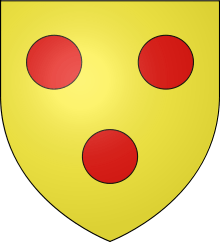Roundel (heraldry)
A roundel is a circular charge in heraldry. Roundels are among the oldest charges used in coats of arms, dating from the start of the age of heraldry in Europe, circa 1200–1215. Roundels are typically a solid colour but may be charged with an item or be any of the furs used in heraldry. Roundels are similar to the annulet, which some heralds would refer to as a false roundel.[1]

Terms for roundels
In some languages, the heraldic roundel has a unique name specific to its tincture, based on the Old French tradition. This is still observed in English-language heraldry, which adopted terms from Old French for specific round items.[2] Thus, while a gold roundel may be blazoned by its tincture, e.g., a roundel or, it is more often described as a bezant, from the Old French term besant for a gold coin, which itself is named for the Byzantine Empire.[1]
The terms and their origin can be seen in the following table:
| Metals | Colours | ||||||||
|---|---|---|---|---|---|---|---|---|---|
| Tincture | Or | Argent | Gules | Azure | Sable | Vert | Purpure | Tenné | Sanguine |
| Name | Bezant | Plate | Torteau | Hurt | Pellet | Pomme | Golpe | Orange | Guze |
| Depiction |  |
 |
 |
 |
 |
 |
 |
 |
 |
| Origin and meaning | Fr. besant, 'gold coin' | Eng. "plate" | Fr. torteau, 'tart' | Eng. "hurtleberry" or Fr. heurt, 'bruise' | Eng. "pellet" | Fr. pomme, 'apple' | Sp. golpe, 'wound' | Eng. "orange" | Turk. گوز göz, 'eye' |
A roundel vert ("green roundel") is known as a pomme, the French word for apple. It was frequently pluralised as pomeis – as in the Heathcote arms: Ermine, three pomeis, each charged with a cross or[1] – but pommes is now more common. The term for a red roundel, torteau, is typically pluralised in the French manner as torteaux rather than torteaus, although torteaus is occasionally seen. A pellet may also be called an ogress.[3]
In modern French blazonry, a roundel of either metal (or or argent) is a besant, and a roundel of any colour (dark tincture) is a torteau, with the tincture specified. However, an alternate naming system has been used for the non-mental tinctures, with similar terms as English heraldry (guse for gules, heurte for azure, ogoesse for sable, somme, volet or pomme for vert, and gulpe for purpure). Archaic names for roundels based on the French tradition are sometimes found in other languages, such as Spanish (see roel) and Portuguese (see arruela)
In German blazonry, the general word for a roundel is Kugel ('ball'); a roundel of silver can also be called Ball, and a roundel of gold Bille.
Special roundels
.svg.png)
Fountain
One special example of a named roundel is the fountain, depicted as a roundel barry wavy argent and azure, that is, containing alternating horizontal wavy bands of blue and silver (or white). Because the fountain consists equally of parts in a light and a dark tincture, its use is not limited by the rule of tincture as are the other roundels. The traditional fountain in heraldry was a barry wavy of six, that is, with six alternating wavy rows of white and blue.[1]
Another name for the fountain is the syke (Northern English for "well").[4][5] One of the most well-known and ancient uses of the fountain is in the arms of the Stourton family. Three fountains appear on the arms of County Leitrim, Ireland.
Semy
In their earliest uses, roundels were often strewn or sown as seeds (Latin: semen, -inis, a seed) upon the field of a coat of arms, blazoned as semée/semy, an arrangement with numerous varieties. For example, a field semy of plates (i.e. roundels argent) could be blazoned platy; a field semy of pellets (i.e. roundels sable) could be blazoned pellety. The precise number and placement of the roundels in such cases were usually left to the discretion of the artist.
See also
References
- Boutell, Charles (1890). Heraldry, Ancient and Modern: Including Boutell's Heraldry. F. Warne. pp. 34-36. Retrieved 14 September 2017.
Plural are termed pomeis.
- Fox-Davies, Arthur Charles (1909). A Complete Guide to Heraldry. p. 151.
- Woodcock, Thomas; Robinson, John Martin (1988). The Oxford Guide to Heraldry. Oxford: Oxford University Press. p. 204. ISBN 0-19-211658-4.
- Fearn, Jacqueline (1980). Discovering Heraldry. Shire. p. 25.
- Scottish National Dictionary of 1700: syke